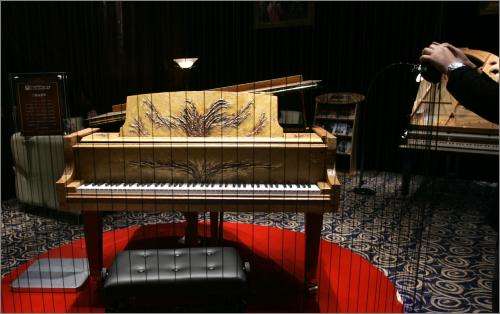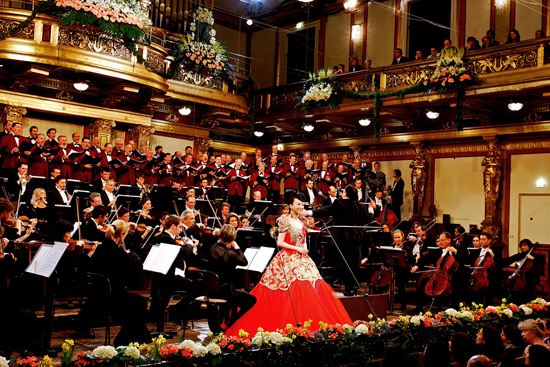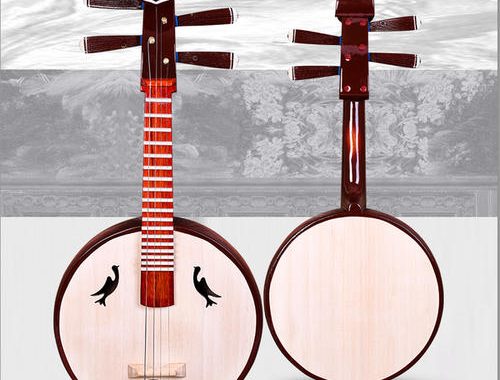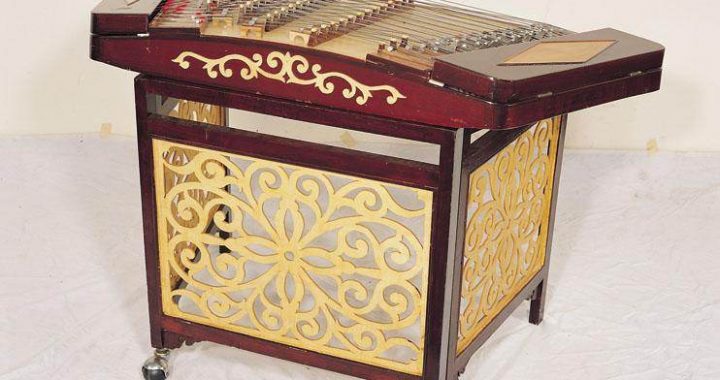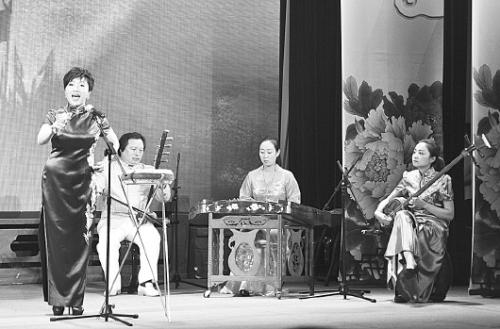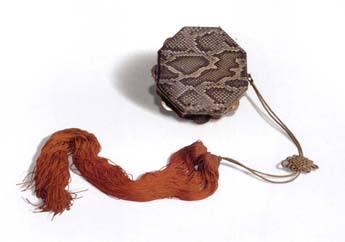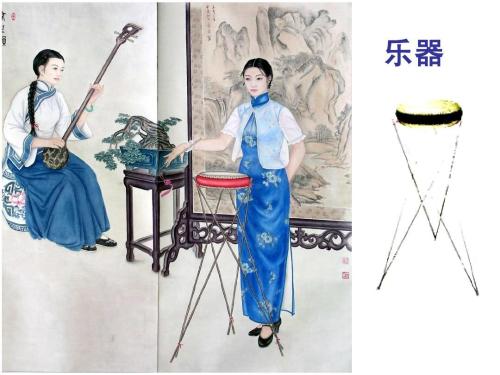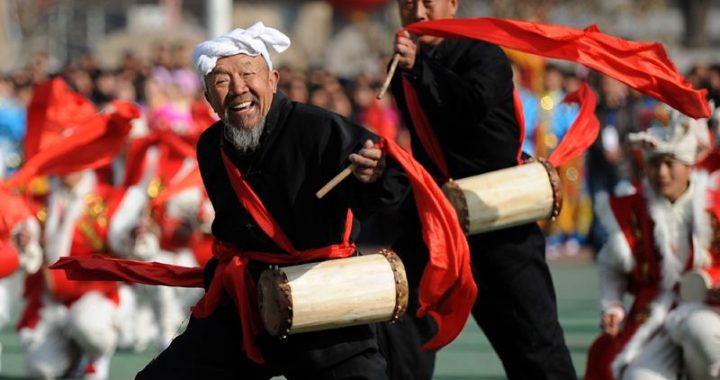Engraving of jiangu drum
4 min readfrom Xihukou, Tengzhou, Shandong Province Han tomb engravings of musical activities most commonly depict performances of jiangu drumming and dancing. The jiangu drum is an elongated, horizontal percussion instrument constructed of several pieces of joined wood, pierced by a long post. The top of the drum is decorated with feathers or other ornaments, and the bottom rests on a stand. In 1958, a complete engraving of a jiangu drum performance, clearly carved in bass-relief, was excavated at Xihukou Village, Tengzhou, Shandong Province. The engraving is divided into eight horizontal sections, with the third, fourth, and fifth sections portraying an audience watching a jiangu drum and dance performance. The drum is at the center, with the tiger-shaped stand and thick canopy-topped post extending vertically through all three sections. One musician stands on either side of the canopy, playing the yu (reed pipes). Underneath the drum, two dancers face each other,lunging and flailing.
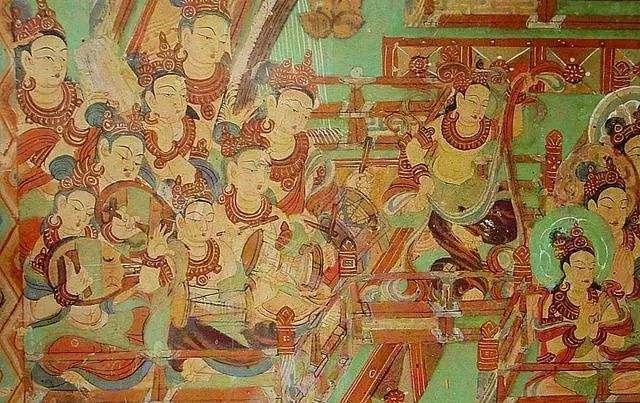
Yu from Han Dynasty Tomb at Mawangdui The yu (reed pipes) and se (25-string zither) were the most widespread musical instruments of the Han Dynasty. As a result, the music of this period is referred to as yuse (pipe and zither) music. The yu was a large reed wind instrument, constructed of multiple bamboo pipes attached to a gourd body and fitted with a reed mouthpiece. The yu was popular from the Warring States Period (475-221 BC) through the Han Dynasty (202 BC-220 AD). It subsequently evolved into the sheng (reed pipes), and is rarely seen today. The yu was only known from Han tomb engravings and terra cotta figurines of musicians until 19 72, when an example in excellent condition was excavated from a Han Dynasty tomb at Mawangdui, in the eastern suburbs of Changsha, Hunan Province. Constructed of bamboo and wood, it is 78 centimeters long, and includes the body, mouthpiece, and 22 pipes. The pipes are divided into front and back rows, and the out-side of the body and mouthpiece is painted with red lacquer.
Se (25-string zither)
from Han Dynasty Tomb One at Mawangdui The se (25-string zither) is the other component of the “pipe and zither music” popular during the Han Dy-nasty. Shijing , compiled 2 500 years ago, contains numerous references to the se. The se is a plucked string instrument with a rectangular wooden body. It generally has 25 strings, although some varieties have 21 to 24 strings. The se was often used to accompany singing at ancient entertainments and ceremonies. Numerous examples of se from the Warring States Period through the Han Dynasty have been excavated from archeological sites in Henan, Hubei, and Hunan provinces. Some of these ancient artifacts came out of the earth looking shiny and new. An exquisite se found in Tomb 5 at Caojiagang, Dangyang,Hubei Province dates from the late Spring and Autumn Period (770-476 BC), and is the earliest example of this ancient instrument found to date.
Bianzhong (tuned bells) from Han tomb at Luozhuang Twelve se, also from the Warring States Period (475-221 BC), were found in the tomb of Marquis Yi of Zeng (dates of birth and death unknown). Due to their excellent state of preservation, it can be seen that the con-struction methods of the time were quite exacting. The most representative example of a Han Dynasty se,dating from the early Western Han Dynasty (202 BC-9 AD), was excavated from Tomb One at Mawangdui,Changsha, Hunan Province in 19 72. This instrument is in perfect condition. Rectangular in shape and 1 16 centimeters long, it is constructed of top and back sections, and designed to be strung with 2 5 strings.
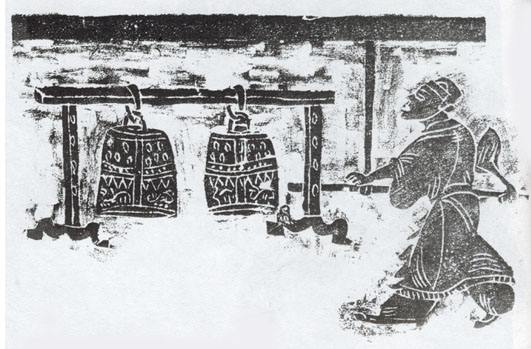
Zhongqing (bell and chime music), the representative music of the Bronze Age, was in decline by the time of the Han Dynasty. However, images of bells and chimes may still be seen in Han tomb engravings and numerous actual instruments have been excavated from Han tombs, indicating that they were still in use during this period. A Han tomb recently discovered at Luozhuang, Zhangqiu, Shandong Province has yielded 149 musical instruments. Among these is a perfectly preserved set of nineteen tuned bells, divided into two tiers and hung on a wooden frame. Beautifully crafted, this set of bells can produce a complete heptatonic scale over a range of two octaves. It is thus perfectly suited to modern music, and can be used to perform almost any contemporary work. Six sets of tuned chimes, composed of 107 individual pieces,were excavated from the Luozhuang Han tomb. In generally good condition, the chimes are made of lime-stone and similar in form. Most of them produce excellent sound, with standardized pitch and a pleasing,bright tone. One set of tuned chimes is pitched almost identically to the set of tuned bells also found in this tomb, capable of producing a complete heptatonic scale over a two octave range. The Luozhuang tuned chimes are the most well preserved, largest, and most functional set discovered to date. More than ten other types of instruments were also found at Luozhuang, including examples of chunyu (military drum),tongzheng (bronze bell-shaped gongs), tongling (bronze bells), se (2 5 -string zithers),jiangu drums, Xiao-biangu (small tuned drums), xuangu (hanging drums), and an instrument that may be a sheng (reed pipes).
The largest discovery of ancient Chinese musical instruments to date, these pieces offer a vivid picture of court music during the Han Dynasty.
Pottery figurines of musicians from Jiyuan, Henan Province With the rise of percussion and wind music during the Han Dynasty, instruments such as paixiao (panpipes),jia (a reed instrument), andjiao (horn) came into widespread use, with examples found throughout Han tomb engravings. The paixiao (panpipes) is an early wind instrument that arose in many places around the world. Depictions of this instrument appear in stone carvings from Mesopotamia. Two paixiao in relatively good condition were excavated from the tomb of Marquis Yi of Zeng.
